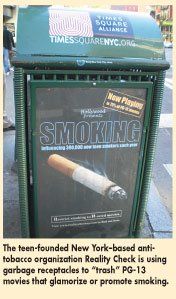Changing risky behavior: What is the government's role in helping people reduce their risk of cancer?
Despite encouraging new treatments, cancer still kills more than 500 million Americans each year. According to the recent report by the President's Cancer Panel, the government is not doing all it should to help reduce Americans' risks of developing cancer
ABSTRACT: Despite encouraging new treatments, cancer still kills more than 500 million Americans each year. According to the recent report by the President's Cancer Panel, the government is not doing all it should to help reduce Americans' risks of developing cancer (see Oncology NEWS International, September 2007, page 32). Cancer Care & Economics (CC&E) spoke with panel member Margaret L. Kripke, PhD, chief academic officer at M.D. Anderson Cancer Center, about the policy steps needed to reduce America's cancer burden.
CC&E: What role can the government play to help Americans reduce their risk of cancer?
DR. KRIPKE: It's important to begin any discussion about reducing cancer incidence with the sobering reminder that upward of 50% of cancer deaths are the avoidable result of tobacco exposure and unhealthy diets.
As our report suggests, without a concerted effort by the public, the government, and the healthcare industry, it is unlikely that we'll be able to make substantial gains in reducing the preventable incidence of cancer. The power of policy to change unhealthy behavior is well recognized and the government has an obligation to protect the public.
CC&E: The panel recommended raising cigarette excise taxes and tougher regulations on sales and marketing. What kind of reception did that suggestion receive from the administration?
DR. KRIPKE: The White House is not required to comment on our report, so we have not received any direct feedback on those recommendations. Quite frankly, the panel urges raising the excise taxes on tobacco because a number of studies have demonstrated that it deters initiation of smoking in youth, and given the fact that more than 80% of adult smokers became addicted as teenagers, we feel that this is one way to directly impact the incidence of tobacco-related cancer.
CC&E: Did the panel address the media's role in tobacco use?
DR. KRIPKE: Yes. For one, we've recommended that the movie industry rate their movies based in part on whether they contain extensive smoking images. I think the film industry is, in fact, now beginning to address this issue. We've come to understand that media portrayals of smoking as pleasurable and glamorous are enormously powerful influences on young people's attitudes about smoking.
We have a shared societal responsibility not to promote the use of deadly tobacco products, and tobacco-control investments should be continued and expanded, along with public and civic awareness.
CC&E: Did the panel identify any socioeconomic factors that lead to higher incidences of unhealthy behavior such as smoking and poor diet?
DR. KRIPKE: The main one that stands out is the lack of access to fresh fruits and vegetables in certain underserved neighborhoods, where people really don't have an abundance of healthy foods. Another issue is the inability to play outside and exercise in neighborhoods that are not safe.
Moreover, studies have shown a correlation between obesity and cancer, and we know that obesity rates are higher among the poor and certain minority groups, so socioeconomic factors point us to areas that need more attention by the government and healthcare agencies.

CC&E: The tobacco industry has a heavy presence on Capitol Hill. Did the panel address their lobbying influence?
DR. KRIPKE: Yes. We made the fairly radical suggestion that political candidates should refuse all campaign contributions from tobacco companies. We also recommended that the tobacco industry needs to have less influence over the political process as a whole. To that end, we made several suggestions, such as prohibiting all federal agencies from accepting money from tobacco companies.
Remember, "big tobacco" spends $41 million per day on marketing and advertising, so the measures required to counteract those very deep pockets need to be quite aggressive.
CC&E: Considering this year's NCI budget cuts, do you think it's realistic to expect more funding to study the dynamics of behavior change?
DR. KRIPKE: About $75 billion a year is spent on caring for people with tobacco-related diseases. Where would you rather spend your money, on end-of-life care or on prevention upfront? So, it's not just a matter of the federal research budget, it's really a matter of how we structure the cost of health care in our country. I know that the NIH budget, which is where most of the research dollars come from, is very tight. But we have to ask ourselves, where could we have the most impact in terms of preventing cancer deaths? Is it by doing large-scale clinical research projects, or by addressing some of the issues that drive smoking and obesity?
CC&E: Should primary care physicians spend more time on preventive medicine instead of acute care?
DR. KRIPKE: Yes, but in order to do that, we have to change the way that medical procedures are reimbursed. Most doctors will tell you that they cannot afford to spend enough time in prevention counseling. A surprising statistic that we found is that only about 20% of patients are actually asked about tobacco use in primary care physician offices.
We emphasized that we need to start spending money on prevention and begin thinking about paying for wellness rather than for taking care of acute episodes and chronic diseases.
CC&E: Any closing thoughts?
DR. KRIPKE: The President's Cancer Panel has noted the growing evidence linking obesity to higher risk of cancer, and the lack of progress in reducing tobacco use.
We have the capability to reach society as a whole and increase awareness of how life-style choices can contribute to cancer risk. We also have the resources to implement population-level solutions to these problems. What we need now is the political will to set things in motion.
Newsletter
Stay up to date on recent advances in the multidisciplinary approach to cancer.